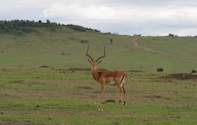
Bushmeat trade is one that provokes stronger emotions than any other aspect of wildlife trade; most people recoil from images of the severed hands or heads of Great Apes, which look all too human...
Yet more than 34 million people living in Africa's Congo Basin depend on wildlife as their significant and direct source of protein. More than one million tonnes of bushmeat are consumed per year in the Democratic Republic of Congo alone. Agricultural food production in this region has not increased significantly throughout the last 40 years, so that many rural societies still depend on wildlife resources.
Most popular with hunters are duikers (small antelopes) and primates—an estimated minimum of 3,000 to 6,000 Great Apes are killed annually for the trade—but overall 42 mammal species of international conservation concern have been identified in the commercial African bushmeat trade, and local extinctions of leopard, golden cat and elephant have been caused through excessive harvest.
Many believe the unsustainable levels of bushmeat trade represent the most immediate threat to the Congo Basin's wildlife over the next 5 to 25 years. Many species are hunted to dangerously low levels with harvesting rates exceeding several times the sustainable rate. Clearly, this conservation crisis needs to be tackled, but in a rational and logical manner.
In its support to Central African governments and their mission to design and implement national bushmeat strategies, TRAFFIC is analysing the bushmeat trade dynamics in selected countries of the region, thereby identifying key priorities and gaps for the whole Central African sub-region. TRAFFIC has also generated some generic research at regional level to answer some basic questions such as what levels of natural wild bushmeat production are possible and under what circumstances? How do land use patterns impact on the productivity of wild bushmeat? Where is bushmeat traded? Even why is it eaten?
Some early results have perhaps been surprising. Bushmeat consumption increases significantly with personal wealth; such food is increasingly regarded as a luxury product throughout much of Central Africa. As such, the development of animal husbandry to supply protein needs may not satisfy the bushmeat demand.
There is also a significant relationship between bushmeat production and population density, with consumption rising per capita as more of the population moves into urban centres—the current trend of urbanisation throughout Central Africa may trigger a large increase in the consumption of bushmeat.
Through understanding the dynamics and market forces driving the bushmeat trade, TRAFFIC expects to be able to help develop solutions to avert this ever looming crisis. Whether TRAFFIC succeeds or not will become obvious in the next 5 to 25 years as the crisis comes to a head.
Much of TRAFFIC's work on bushmeat has been undertaken thanks to funding provided by BMZ, the German Federal Ministry for Economic Cooperation and Development.
Dr Richard Thomas

